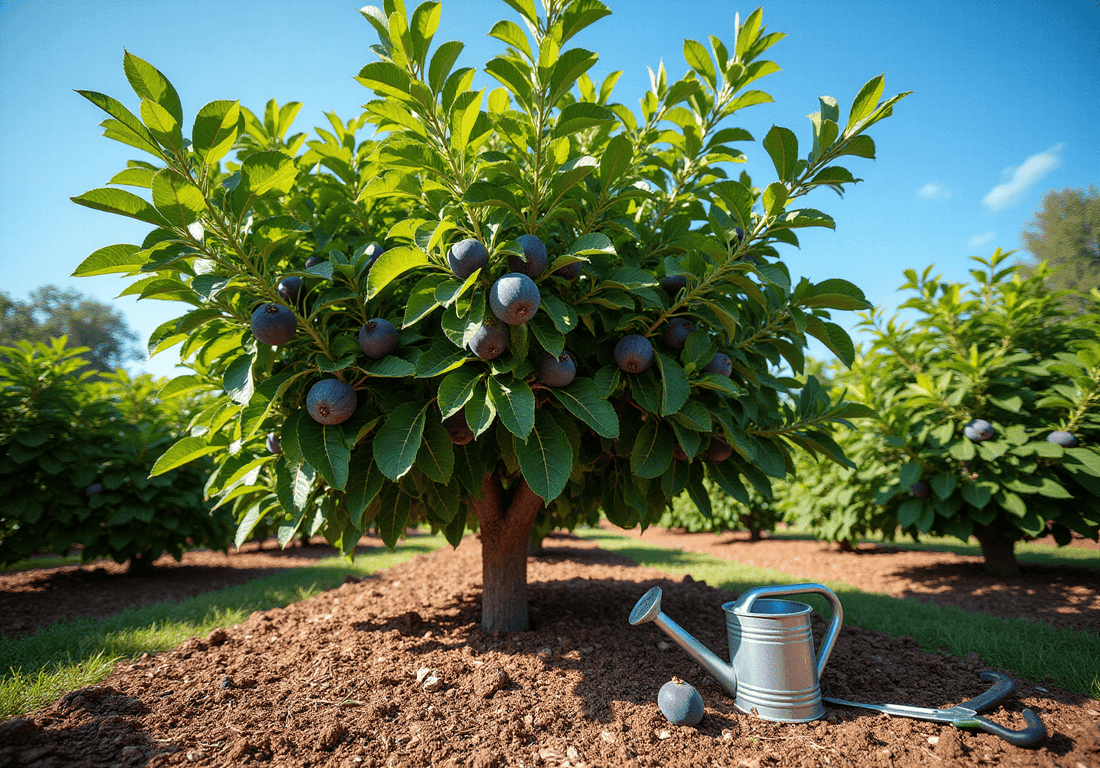
Master Violette de Bordeaux Fig Care for Thriving Growth
Share
The Violette de Bordeaux fig tree is a prized addition to any garden, celebrated for its luscious fruits and stunning foliage. However, to truly thrive, this exquisite variety requires specific care. Understanding its unique growing requirements and optimal care techniques is essential for gardeners aiming for successful cultivation. Many enthusiasts encounter challenges in maintaining the right conditions and effectively managing pests. Therefore, it is crucial to explore the best practices that ensure robust growth and a bountiful harvest of these delectable figs.
Want to grow a fig tree in your garden?
Explore Violette de Bordeaux Fig for sale at Everglades Farm - shipped directly from Florida.
1. Understand the Growing Requirements for Violette de Bordeaux Fig Trees
Plants of the violette de Bordeaux fig are well-suited for USDA hardiness zones 7-10, thriving in well-drained, loamy soil with a slightly acidic to neutral pH range of 6.0 to 6.5. These plants benefit from full sun exposure, ideally receiving a minimum of 6 to 8 hours of direct sunlight each day to ensure optimal fruit yield. During the growing season, it is crucial to maintain consistent moisture; deep watering once a week is recommended, especially during dry spells, to avoid waterlogging. Specifically, these plants require approximately 12-15 gallons of water weekly from May to September. Additionally, applying a layer of mulch around the base helps retain soil moisture and regulate temperature, creating an ideal environment for robust growth.
To promote vigorous growth and fruiting, it is advisable to fertilize the fig plant with a balanced fertilizer once in the spring and once in the summer. Mature Violette de Bordeaux fig plants can reach heights of 12-20 feet, which makes proper pruning essential for managing their size and shape. When considering the acquisition of these plants, it is important to take into account, as they are typically sent bareroot during their winter dormancy from January through May.
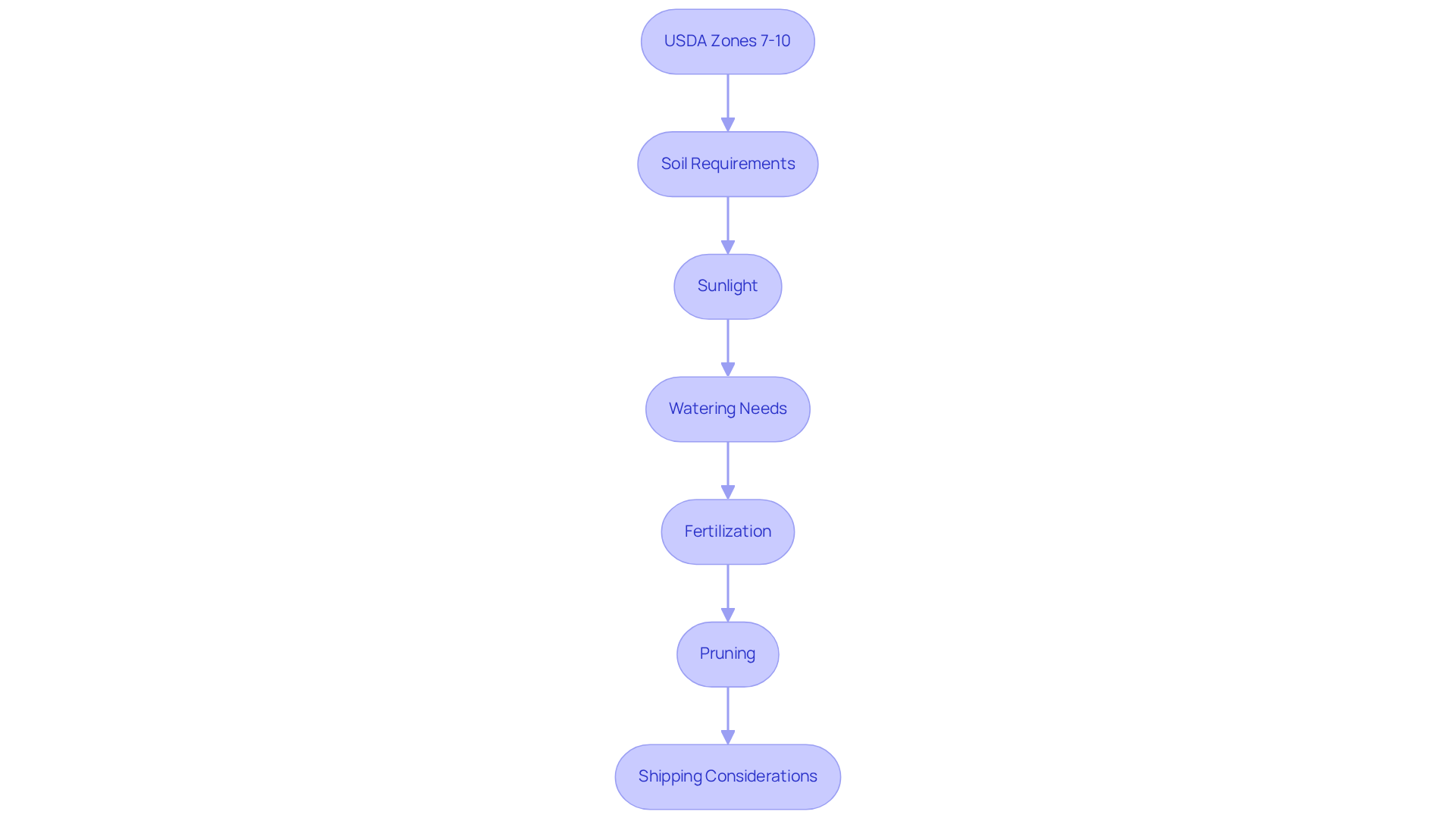
2. Implement Effective Care Techniques for Optimal Growth
For optimal growth of Violette de Bordeaux fig plants, it is essential to apply a balanced organic fertilizer. A fertilizer with a 10-10-10 or 20-10-20 NPK ratio should be used in early spring as new growth begins.
Regular pruning is vital for maintaining the plant's size and promoting better air circulation, which is crucial for reducing disease risk. This practice should be conducted in late winter or early spring, focusing on the removal of dead or overcrowded branches to and airflow.
Statistics indicate that appropriate pruning methods can significantly enhance fruit production and plant health, making it an essential practice for any fig gardener. A case study on the Violette de Bordeaux fig plants emphasizes that consistent pruning enhances development and contributes to the overall vitality of the plant, ensuring a plentiful harvest.
Furthermore, being vigilant about pests like fig beetles and aphids is crucial; utilizing organic pest management techniques can help maintain a healthy ecosystem surrounding the plant.
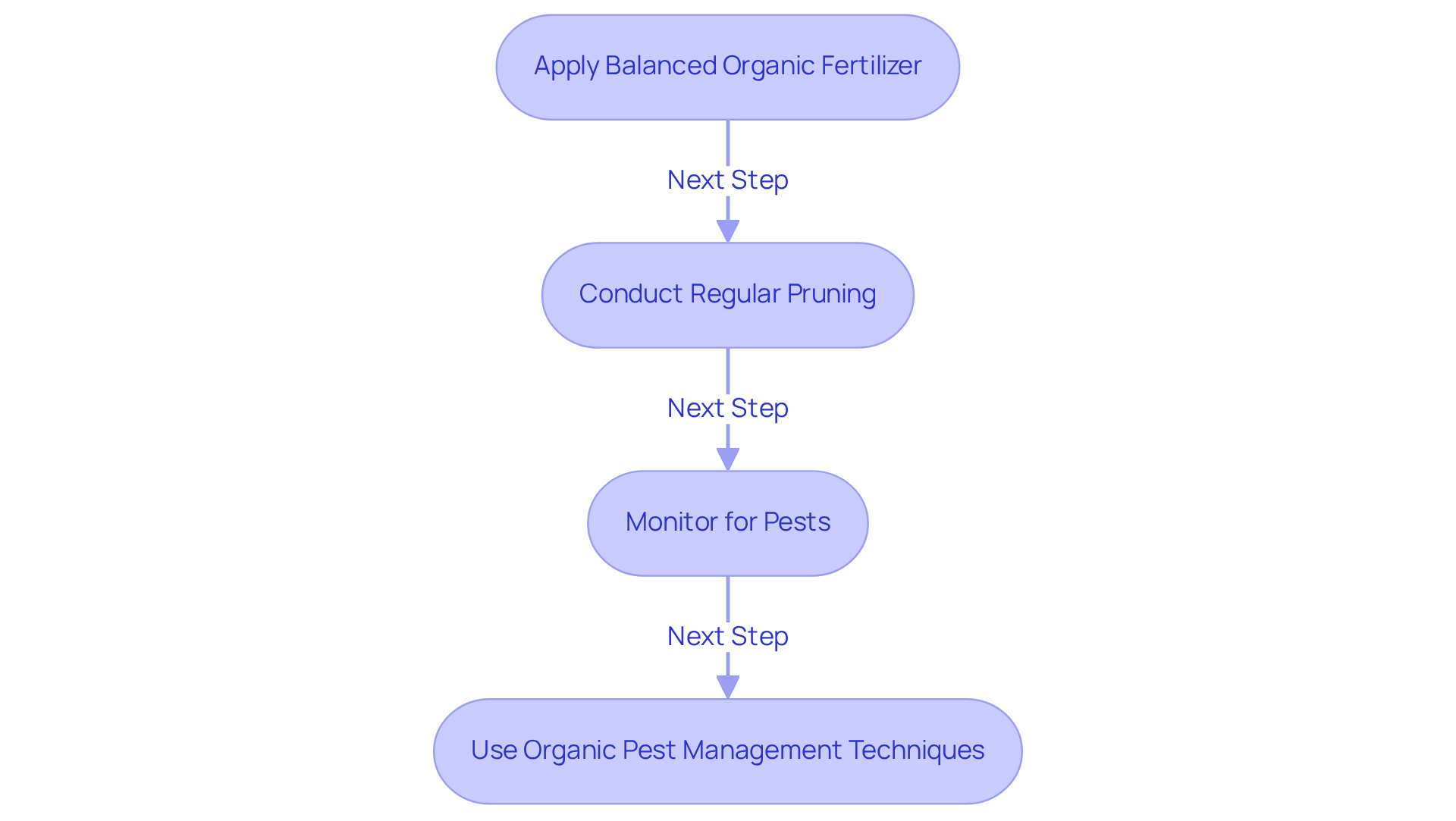
3. Choose the Ideal Planting Location and Conditions
Choosing the appropriate planting site is essential for the thriving development of the Violette de Bordeaux fig. Aim for areas that receive full sun for at least 6 to 8 hours daily, as this exposure significantly enhances the health and fruit production of Violette de Bordeaux fig. As Lisa Mulroy states, 'The Violette de Bordeaux fig thrives best in full sun, needing at least eight hours of direct sunlight each day.' South-facing slopes are particularly beneficial, maximizing sunlight and warmth while providing shelter from harsh winds.
Adequate drainage of the ground is crucial; the Violette de Bordeaux fig plants favor well-draining earth with a pH level between 6.0 and 6.5. If your soil is heavy clay, consider using raised beds to facilitate better drainage and prevent root rot. Additionally, ensure adequate spacing by planting these Violette de Bordeaux fig plants at least 12 to 18 feet apart. This distance allows for sufficient air circulation, reducing the risk of disease and promoting healthy growth.
In colder climates, it's essential to safeguard young plants during winter by wrapping them in burlap or moving potted specimens indoors to shield them from frost. Watering the soil a few days before an upcoming freeze is also a helpful practice.
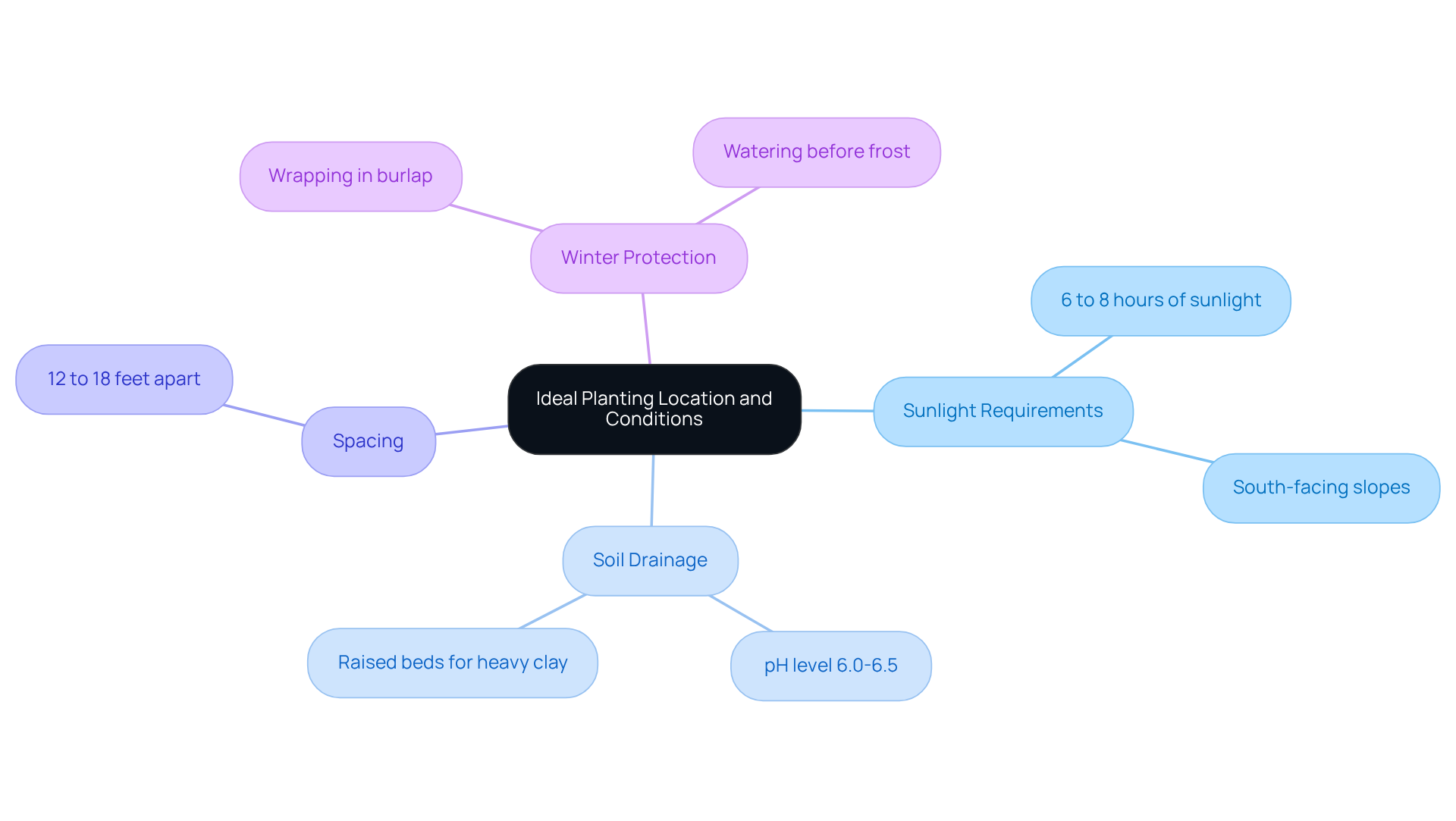
4. Engage with the Gardening Community for Shared Insights
Engaging with gardening forums, local clubs, or online communities focused on the cultivation of violette de bordeaux fig provides invaluable resources for both novice and experienced gardeners. These platforms facilitate the sharing of personal experiences, allowing members to ask questions and receive tailored advice based on their unique growing conditions.
With approximately 18,000 community gardens in the U.S. and over 3 million gardeners involved, these discussions can lead to innovative solutions for common challenges, such as:
- Pest management
- Pruning techniques
- Seasonal care
This fosters camaraderie among participants. Additionally, attending local gardening workshops or events not only enhances knowledge but also connects individuals with seasoned growers who can provide personalized tips and insights.
As Dr. Mary Rowe notes, community gardens serve as powerful tools for building stronger, healthier communities, making engagement in these spaces essential for enriching the cultivation journey of the violette de bordeaux fig.
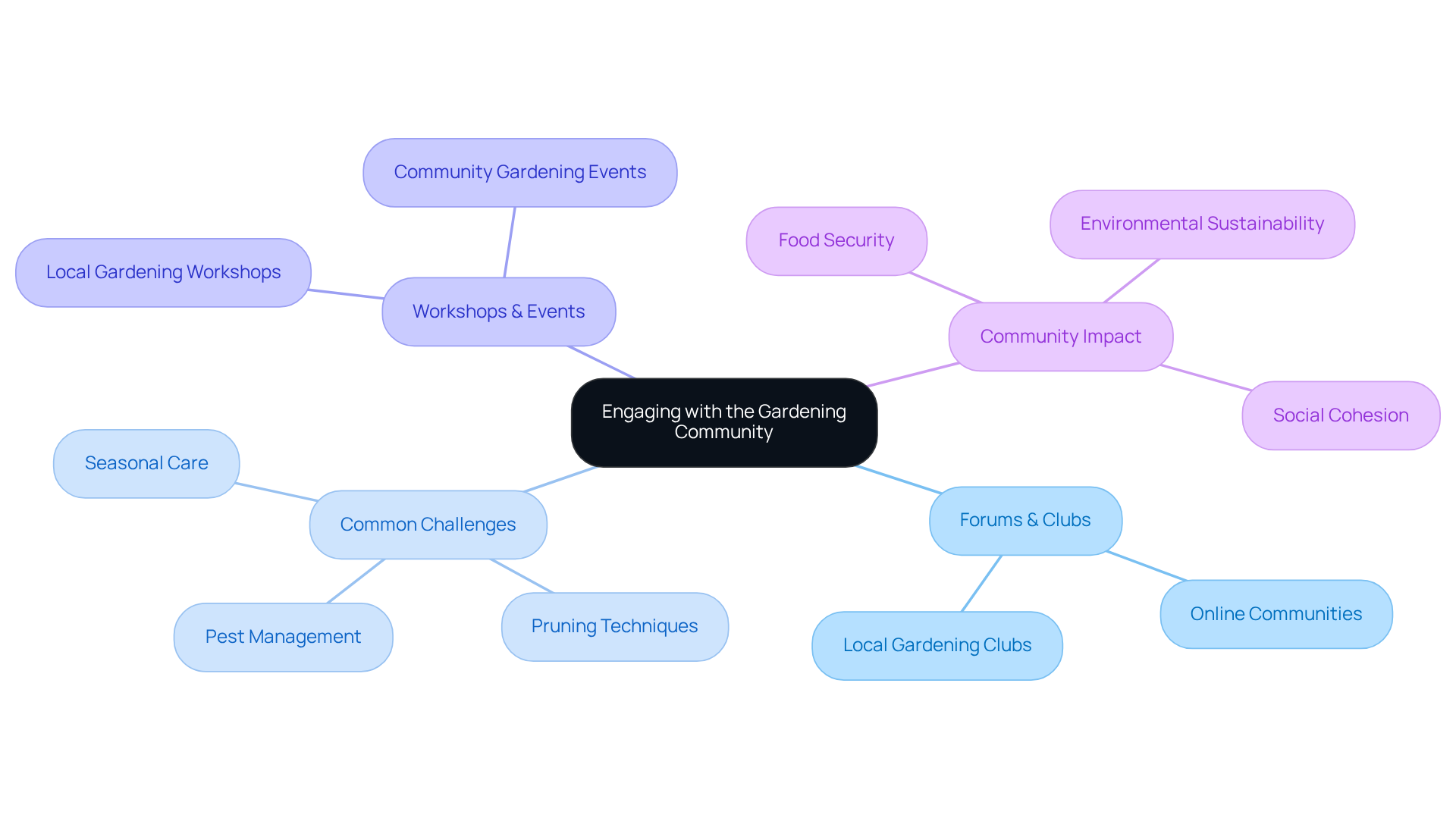
Conclusion
Mastering the care of Violette de Bordeaux fig trees is essential for achieving thriving growth and bountiful harvests. By understanding their specific needs—optimal sunlight exposure, well-drained soil, and consistent watering practices—gardeners can create ideal conditions for these remarkable plants. Implementing effective care techniques, such as balanced fertilization and regular pruning, further enhances their health and productivity, ensuring that growers can enjoy the sweet rewards of their labor.
Key aspects of Violette de Bordeaux fig care include:
- Selecting the right planting location with ample sunlight
- Maintaining proper soil conditions
- Engaging in community discussions to share insights and strategies
Adopting practices like organic pest management and seasonal care can significantly improve the overall vitality of the plants. By fostering a supportive gardening community, individuals can learn from one another and tackle common challenges together, enriching their gardening experience.
Ultimately, cultivating Violette de Bordeaux fig trees is not just about the plants themselves but also about the journey of growth, learning, and community engagement. Embracing these practices and sharing knowledge with fellow gardeners can lead to healthier plants and a more fruitful gardening adventure. Taking the time to implement these best practices will not only enhance the beauty of any garden but also ensure a plentiful harvest season after season.
Grow Your Own Tropical Paradise Today!
Join the Everglades Farm community and cultivate thriving Violette de Bordeaux figs with expert care tips and premium plants.
Frequently Asked Questions
What are the ideal growing conditions for Violette de Bordeaux fig trees?
Violette de Bordeaux fig trees thrive in USDA hardiness zones 7-10, prefer well-drained, loamy soil with a slightly acidic to neutral pH of 6.0 to 6.5, and require full sun exposure with a minimum of 6 to 8 hours of direct sunlight daily.
How often should I water Violette de Bordeaux fig trees?
These fig trees should be watered deeply once a week, especially during dry spells, requiring approximately 12-15 gallons of water weekly from May to September.
What is the role of mulch for Violette de Bordeaux fig trees?
Applying a layer of mulch around the base of the fig tree helps retain soil moisture and regulate temperature, creating an ideal environment for robust growth.
How often should I fertilize Violette de Bordeaux fig trees?
It is advisable to fertilize Violette de Bordeaux fig trees with a balanced fertilizer once in the spring and once in the summer to promote vigorous growth and fruiting.
How tall can mature Violette de Bordeaux fig trees grow?
Mature Violette de Bordeaux fig trees can reach heights of 12-20 feet, making proper pruning essential for managing their size and shape.
When are Violette de Bordeaux fig trees typically shipped?
These plants are usually sent bareroot during their winter dormancy from January through May.

